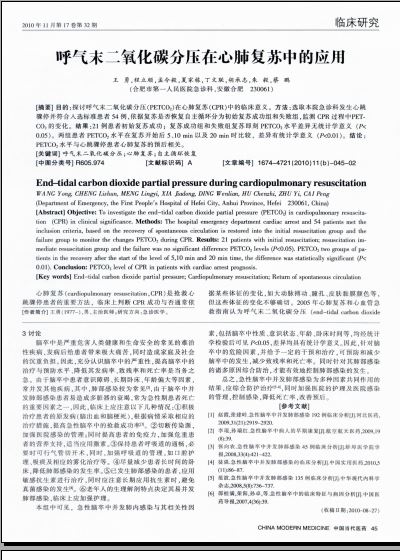呼气末二氧化碳分压在心肺复苏中的应用(2)
 |
| 第1页 |
参见附件(1241KB,2页)。
由于本研究的样本数有限,需要大样本的病例进一步验证,在以后的研究中进一步扩大样本数量,同时进行分层分析,进一步明确不同病因导致的心跳骤停其PETCO2的变化规律;并观察其与远期的预后情况。
[参考文献]
[1]Miran K,Miljenko K,Klemen P,et al.Partial pressure of end-tidal carbon dioxide successful predicts cardiopulmonary resuscitation in the field:a prospective observational study[J].Critical Care,2008,12(5):115.
[2]Grmec S,Klemen P.Does the end-tidal carbon dioxide(EtCO2)concentration have prognostic value during out–of-hospital cardiac arrest[J].Eur J EmergMed,2001,8(4):263–269.
[3]Grmec S,Lah K,Tusek-Bunc K.Difference in end-tidal CO2 between asphyxia cardiac arrest and ventricular fibrillation/pulse-less ventricular tachycardia cardiac arrest in the prehospital setting[J].Crit Care,2003,7(6):139-144.
[4]William E.2005 American Heart Association guidelines for cardiopulmonary resuscitation and emergency cardiovascular care[J].Circulation,2005,112(24 suppl):78-83.
[5]刘瑛琪,钱方毅.2005年美国心脏学会(AHA)心肺复苏与心血管急救指南解读连载[J].中国急救复苏与灾害医学杂志,2006,1:104-106,159-1641.
[6]陈旭岩,冯莉莉,刘娟,等.潮气末二氧化碳分压评价心跳骤停患者心肺复苏的预后[J].中国急救复苏与灾害医学杂志,2007,2(3):132-134.
[7]陈英杰,陈运立,吴贤仁.心肺复苏期间潮气末二氧化碳(PETCO2)监测及临床意义[J].河北医学,2004,10(1):56-58.
(收稿日期:2010-09-16)
您现在查看是摘要介绍页,详见PDF附件(1241KB,2页)。